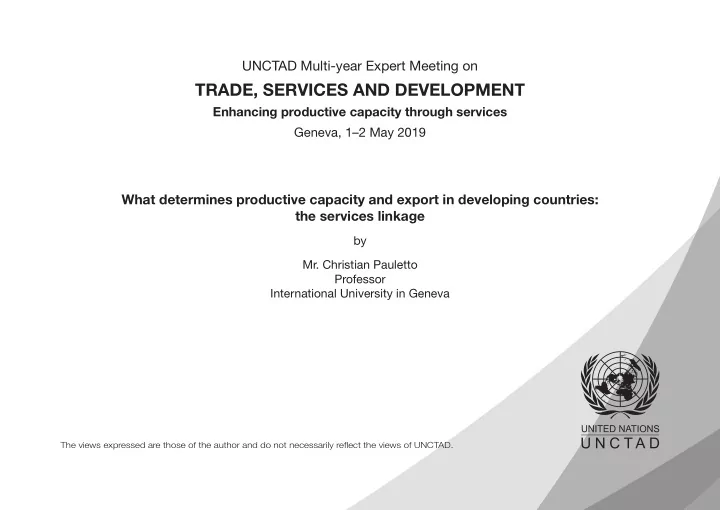

UNCTAD Multi-year Expert Meeting on TRADE, SERVICES AND DEVELOPMENT Enhancing productive capacity through services Geneva, 1–2 May 2019 What determines productive capacity and export in developing countries: the services linkage by Mr. Christian Pauletto Professor International University in Geneva The views expressed are those of the author and do not necessarily refmect the views of UNCTAD.
UNCTAD Multi-year Experts Meeting on Trade, Services and Development Geneva, Palais des Nations, 1 May 2019 Prof. Christian Pauletto International University in Geneva , IUG cpauletto@iun.ch
Question raised: «How do services enhance a country’s productive capacity in terms of productive resources and production linkages?» (para 58 of doc TD/B/C.I/MEM.4/20) «What determines the productive capacity of a country?»
“Productive capacity” Definition: “the productive resources (1), entrepreneurial capabilities (2) and production linkages (3) which together determine the capacity of a country to produce goods and services and enable it to grow and develop.” (UNCTAD, The Least Developed Countries Report, 2006: Productive Capacities , p. 61)
First caveat: Studies, findings, etc based mainly on developed countries do not necessarily reflect the specificities of Least Developed Countries and other Developing Countries
Second caveat: difference goods productive capacity vs services productive capacity Switzerland has no mines, but the major global mining company Switzerland has no sea shore, but a major shipping company Other success stories: Aramex (Jordan/UAE), Mercadolibre (ARG), Lion Air (ID), Safaricom (Kenya)
Aramex : Founded 1982 in Jordan, headquarters then moved to Dubai. «We have successfully introduced market leading express delivery and logistics services to the Middle East and other emerging economies. As a leading global provider of comprehensive logistics and transportation solutions, our breadth of services include express courier delivery, freight forwarding, logistics, supply chain management, e-commerce and record management services.” (source: Aramex web-site)
«Instead of investing heavily in infrastructure, we acquire or partner with domestic-focused logistics companies that have strong local networks, knowledge and transportation solutions already in place for efficient and effective last-mile delivery.” (source: Aramex web- site) 2018 acquisition of the KSA-based Saudi TAL for Commerce and Contract Company Ltd . In 2011, Aramex acquired OneWorld Courier and In- Time Couriers , two Kenyan courier firms and Berco Express , a South African logistics firm.
More productive ? more exports of capacity goods and services
More productive capacity more exports of + goods and services Supportive trading environment (competitiveness)
Typical services inputs in the Value Chain: Air transport Sea cargo Inland transport Energy Telecommunication and Internet access (connectivity) Utilities Education, training and skills (e.g. management training, trade skills, technology fluency), in particular for SMEs
Typical export sectors of Least Developed Countries (goods and services): Extractive industry Agriculture Tourism
Creative industry International Domestic transport transport Waste mgt Tourism services Financial Construction services Telecommunication Water (incl. BtoB) Connectivity supply Electricity
«it remains crucial to increase supply capacity in services themselves to allow countries to benefit from their enabling potential .» (para 35 of doc TD/B/C.I/MEM.4/20)
« Infrastructure is a prerequisite for transport services, which facilitate trade .» (para 45 of doc TD/B/C.I/MEM.4/20)
« Least developed countries are particularly lagging behind when it comes to benefiting from the potential of information and telecommunications services to enable international trade .» (para 30 of doc TD/B/C.I/MEM.4/20)
WEF Global Enabling Trade Index (ETI) (https://www.weforum.org/reports) ETI Country profiles (http://reports.weforum.org/global-enabling-trade- report-2016/economy-profiles/.)
Four overall key subindexes (A to D) containing 7 pillars: A. Market access B. Border administration C. Transport and ICT infrastructure D. Operating environment
Subindex A: Market access Pillar 1: Domestic market access Pillar 2: Foreign market access Subindex B: Border administration Pillar 3: Efficiency and transparency of border administration Subindex C: Infrastructure Pillar 4: Availability and quality of transport infrastructure Pillar 5: Availability and quality of transport services Pillar 6: Availability and use of ICTs Subindex D: Operating environment Pillar 7: Operating environment
Subindex C: Infrastructure Pillar 4: Availability and quality of transport infrastructure 4.01 Available airline seat kilometers millions 4.02 Quality of air transport infrastructure 4.03 Quality of railroad infrastructure 4.04 Liner Shipping Connectivity Index 0–157.1 (best) 4.05 Quality of port infrastructure 4.06 Road quality index 4.07 Quality of roads
Subindex C: Infrastructure Pillar 5: Availability and quality of transport services 5.01 Ease and affordability of shipment 1–5 (best) 5.02 Logistics competence [ seamless logistics chain ] 1– 5 (best) 5.03 Tracking and tracing ability 1–5 (best) 5.04 Timeliness of shipments to destination 1–5 (best) 5.05 Postal service efficiency 5.06 Efficiency of transport mode change [ transshipment ]
Subindex C: Infrastructure Pillar 6: Availability and use of ICTs 6.01 Mobile-cellular telephone subscriptions /100 pop. 6.02 Internet users % pop. 6.03 Fixed-broadband Internet subscriptions /100 pop. 6.04 Mobile-broadband subscriptions /100 pop. 6.05 ICT use for biz-to-biz transactions 6.06 Internet use for biz-to-consumer transactions 6.07 Government Online Service Index 0–1 (best)
Senegal 2016:
Senegal 2016:
Cambodia 2015:
Cambodia 2015:
Recommendations (1) : Identify key economic activities of your economy 1. Identify major services linkages (inputs) for such 2. activities Check whether such services are available to all 3. producers (esp. SMEs) in adequate quantity, diversity, quality (skills) and affordability, incl. issues of seasonality (e.g. tourism) Find and implement policy actions to improve 4. supply (quantity, quality etc) (avoid bottlenecks), incl. with international organizations
Recommendations (2) : «Policy action» shall consider in particular: - improve education in targeted skills (e.g. creative skills, management skills) as well as general; - institutions-building: skills of the regulators; - the regional dimension (regional markets, regional cooperation).
Thanks for your attention
Recommend
More recommend